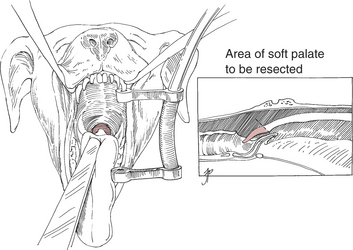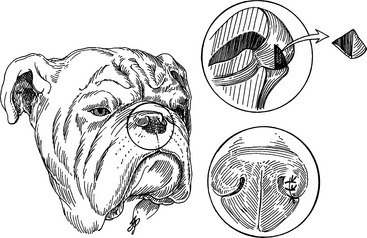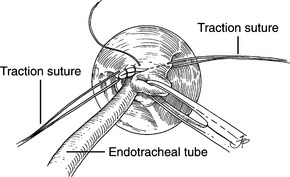Chapter 161 Obstructive Upper Airway Disorders
Obstructive upper airway diseases typically are insidious in onset and result in progressively worsening respiratory stridor and dyspnea. The dimensions of the upper airway play a fundamental role in the efficiency of breathing and progression of disease. In narrowed regions of the upper airway, air velocity is higher and pressure is lower than elsewhere (Bernoulli effect), which tends to narrow susceptible regions of the upper airway still more.
ETIOLOGY
Brachycephalic Syndrome
Laryngeal Paralysis
This condition is seen primarily in old, large-breed, and giant-breed dogs. Interruption of the innervation to the intrinsic muscles of the larynx, particularly the cricoarytenoideus dorsalis muscle, results in failure of the arytenoid cartilages and vocal folds to abduct during inspiration. The condition is a congenital anomaly in some breeds, such as the Bouvier des Flandres, Siberian husky, and dalmatians. Laryngeal paralysis also has been associated with hypothyroidism (see Chapter 31) and diffuse polyneuropathies in dogs (see Chapter 129). In many cases laryngeal paralysis is idiopathic.
Nasopharyngeal Polyps
These inflammatory masses arise from the epithelium of the nasopharynx, auditory canal, or tympanic cavity (see Chapters 59 and 61).
Tracheal Collapse
Primary Tracheal Neoplasia
These tumors are uncommon in dogs and rare in cats.
Extraluminal Compression of the Trachea
Segmental tracheal stenosis can be caused by compression from extraluminal masses such as parasitic granulomas (Oslerus [Filaroides] osleri), thyroid carcinoma (see Chapter 31), hilar lymphadenopathy (see Chapter 165), left atrial enlargement (see Chapter 149), mediastinal lymphoma (see Chapter 27), and mediastinal lipoma.
CLINICAL SIGNS
Stertor and Stridor
Dyspnea
Dyspnea is observed in most animals with obstructive upper respiratory disease.
Cough
DIAGNOSIS
History
Physical Examination
The physical examination often is unremarkable in dogs with obstructive upper respiratory diseases.
Oropharyngeal Examination
Brachycephalic Syndrome
Laryngeal Paralysis
Laryngeal Collapse
Radiography
Obtain radiographs of the pharyngeal, cervical, and thoracic regions.
TREATMENT
Brachycephalic Syndrome
Nasal Wedge Resection
Preoperative Considerations
Surgical Procedure
Technique
Staphylectomy (Correction of Elongated Soft Palate)
Surgical Procedure
Technique

Figure 161-2 Staphylectomy for elongated soft palate. The area of soft palate to be resected is in red.





